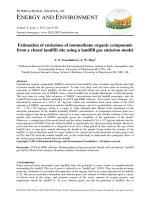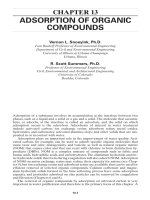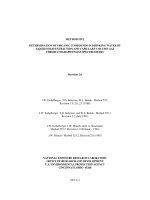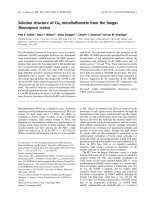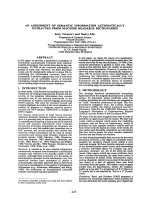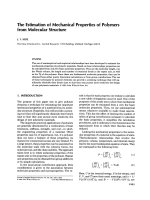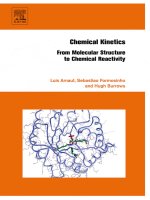PREDICTION OF CHEMICAL REACTIVITY PARAMETERS AND PHYSICAL PROPERTIES OF ORGANIC COMPOUNDS FROM MOLECULAR STRUCTURE USING SPARC pptx
Bạn đang xem bản rút gọn của tài liệu. Xem và tải ngay bản đầy đủ của tài liệu tại đây (1.99 MB, 158 trang )
EPA/600/R-03/030
March 2003
PREDICTION OF CHEMICAL REACTIVITY
PARAMETERS AND PHYSICAL PROPERTIES OF
ORGANIC COMPOUNDS FROM MOLECULAR
STRUCTURE USING SPARC
By
S.H. Hilal and S.W. Karickhoff
Ecosystems Research Division
Athens, Georgia
and
L.A. Carreira
Department of Chemisty
University of Georgia
Athens, GA
National Exposure Research Laboratory
Office of Research and Development
U.S. Environmental Protection Agency
Research Triangle Park, NC 27711
DISCLAIMER
The United States Environmental Protection Agency through its Office of Research
and Development partially funded and collaborated in the research described here under
assistance agreement number 822999010 to the University of Georgia. It has been subjected
to the Agency peer and administration review process and approved for publication as an
EPA document.
ABSTRACT
The computer program SPARC (SPARC Performs Automated Reasoning in Chemistry) has
been under development for several years to estimate physical properties and chemical reactivity
parameters of organic compounds strictly from molecular structure. SPARC uses computational
algorithms based on fundamental chemical structure theory to estimate a variety of reactivity
parameters. Resonance models were developed and calibrated on more than 5000 light absorption
spectra, whereas electrostatic interaction models were developed using more than 4500 ionization
pK
a
s in water. Solvation models (i.e., dispersion, induction, dipole-dipole, hydrogen bonding, etc.)
have been developed using more than 8000 physical property data points on properties such as
vapor pressure, boiling point, solubility, Henry’s constant, GC retention times, K
ow
, etc. At the
present time, SPARC predicts ionization pK
a
(in the gas phase and in many organic solvents
including water as function of temperature), carboxylic acid ester hydrolysis rate constants (as
function of solvent and temperature), E
1/2
reduction potential (as function of solvents, pH and
temperature), gas phase electron affinity and numerous physical properties for a broad range of
molecular structures.
ii
FOREWORD
Recent trends in environmental regulatory strategies dictate that EPA will rely heavily on
predictive modeling to carry out the increasingly complex array of exposure and risk assessments
necessary to develop scientifically defensible regulations. The pressing need for multimedia,
multistressor, multipathway assessments, from both the human and ecological perspectives, over
broad spatial and temporal scales, places a high priority on the development of broad new modeling
tools. However, as this modeling capability increases in complexity and scale, so must the inputs.
These new models will necessarily require huge arrays of input data, and many of the required
inputs are neither available nor easily measured. In response to this need, researchers at ERD-
Athens have developed the predictive modeling system, SPARC, which calculates a large number
of physical and chemical parameters from pollutant molecular structure and basic information about
the environment (media, temperature, pressure, pH, etc.). Currently, SPARC calculates a wide
array of physical properties and chemical reactivity parameters for organic chemicals strictly from
molecular structure.
Rosemarie C. Russo, Ph.D.
Director
Ecosystems Research Division
Athens, Georgia
iii
TABLE OF CONTENTS
1. GENERAL INTRODUCTION 1
2. SPARC COMPUTATIONAL METHOD 5
3. CHEMICAL REACTIVITY PARAMETERS 6
3.1. Estimation of Ionization pK
a
in Water 7
3.1.1. Introduction 7
3.1.2. SPARC's Chemical Reactivity Modeling 8
3.1.3. Ionization pK
a
Computational Approach 9
3.1.4. Ionization pK
a
Modeling Approach 11
3.1.4.1. Electrostatic Effects Models 12
3.1.4.1.1. Field Effects Model 13
3.1.4.1.2. Mesomeric Field Effects 17
3.1.4.1.3. Sigma Induction Effects Model 19
3.1.4.2. Resonance Effects Model 20
3.1.4.3. Solvation Effects Model 21
3.1.4.4. Intramolecular H-bonding Effects Model 23
3.1.4.5. Statistical Effects Model 24
3.1.4.6. Temperature Dependence 24
3.1.5. Results and Discussion 25
3.1.6. Training and Testing of Ionization pK
a
calculator 28
3.1.7. Conclusion 31
3.2. Estimation of Zwitterionic Equilibrium Constant, Microscopic
Constants Molecular Speciation, and Isoelectric Point 32
3.2.1. Introduction 33
3.2.2. Calculation of Macroconstants 33
3.2.3. Zwitterionic Equilibria:Microscopic Constant 34
3.2.4. Speciation-Two Ionizable Sites 36
3.2.5. Speciation of Multiple Ionization Sites 41
3.2.6. Isoelectric Points 48
3.2.7. Conclusion 50
3.3. Estimation of Gas Phase Electron Affinity 51
3.3.1. Introduction 51
iv
3.3.2. Electron Affinity Computational Methods 51
3.3.3. Electron Affinity Models 52
3.3.3.1. Field Effects Model 54
3.3.3.2. Sigma Induction Effects Model 55
3.3.3.3. Resonance Effects Model 56
3.3.4. Results and Discussion 56
3.3.5. Conclusion 61
3.4. Estimation of Ester Hydrolysis Rate Constant 62
3.4.1. Introduction 62
3.4.1.1. Base-Catalyzed Hydrolysis 62
3.4.1.2. Acid-Catalyzed Hydrolysis 63
3.4.1.3. General-Catalyzed Hydrolysis 64
3.4.2. SPARC Modeling Approach 64
3.4.3. Hydrolysis Computational Model 65
3.4.3.1. Reference Rate Model 66
3.4.3.2. Internal Perturbation Model 67
3.4.3.2.1. Electrostatic Effects Models 78
3.4.3.2.1.1. Direct Field Effect Model 68
3.4.3.2.1.2. Mesomeric Field Effects Model 69
3.4.3.2.1.3. Sigma Induction Effects Model 70
3.4.3.2.1.4. R
π
Effects Model 70
3.4.3.2.2. Resonance Effects Model 71
3.4.3.2.3.
Steric Effect Model 72
3.4.3.3. External Perturbation Model 73
3.4.3.3.1. Solvation Effect 73
3.4.3.3.1.1. Hydrogen Bonding 73
3.4.3.3.1.2. Field Stabilization Effect 75
3.4.3.3. Temperature Effect 76
3.4.4. Results and Discussions 76
3.4.5. Conclusion 80
4. PHYSICAL PROPERTIES
4.1. Estimation of Physical Properties 81
4.2. Physical Properties Computational Approach 82
4.3. SPARC Molecular Descriptors 83
4.3.1. Average Molecular Polarizability 83
4.3.1.1. Refractive Index 84
4.3.1.2. Molecular Volume 87
4.3.1.3. Microscopic Bond Dipole 88
4.3.1.4. Hydrogen Bonding 89
4.4. SPARC Interaction Models 91
4.4.1. Dispersion Interactions 91
4.4.2. Induction Interactions 92
4.4.3. Dipole-Dipole Interaction 93
v
4.4.4. Hydrogen Bonding Interactions 94
4.4.5. Solute-Solvent Interactions 95
4.5. Solvents 97
4.6. Physical Process Models 98
4.6.1. Vapor Pressure Model 98
4.6.2. Activity Coefficient Model 101
4.6.3. Crystal Energy Model 102
4.6.4. Enthalpy of Vaporization 104
4.6.5. Temperature Dependence of Physical Process Models 105
4.6.6. Normal Boiling Point 107
4.6.7. Solubility 108
4.6.8. Mixed Solvents 109
4.6.9. Partitioning Constants 110
4.6.9.1. Liquid/Liquid Partitioning 111
4.6.9.2. Liquid/Solid Partitioning 112
4.6.9.3. Gas/liquid (Henry's constant) Partitioning 113
4.6.9.4. Gas/Solid Partitioning 113
4.6.10. Gas Chromatography 114
'
4.6.10.1. Calculation of Kov
ats Indices
116
4.6.10.2. Unified Retention Index 117
4.6.11. Liquid Chromatography 118
4.6.12. Diffusion Coefficient in Air 120
4.6.13. Diffusion Coefficient in Water 121
4.7. Conclusion 122
5. PHYSICAL PROPERTIES COUPLED
WITH CHEMICAL REACTIVITY MODELS
5.1. Henry’s Constant for Charged Compounds 123
5.1.1. Microscopic Monopole 124
5.1.2. Induction-Monopole Interaction 124
5.1.3. Monopole-Monopole Interaction 125
5.1.4. Dipole-Monopole Interaction 125
5.1.5. Hydrogen Bonding Interactions 126
5.2. Estimation of pK
a
in the Gas Phase and in non-Aqueous Solution 126
5.3. E
1/2
Chemical Reduction Potential 127
5.4. Chemical Speciation 129
5.5. Hydration 130
5.6. Process Integration 133
5.7. Tautomeric Equilibria 134
5.8. Conclusion 136
6. MODEL VERIFICATION AND VALIDATION
vi
138
7. TRAINING AND MODEL PARAMETER INPUT 139
8. QUALITY ASSURANCE 139
9. SUMMAY 140
10. REFERENCES 143
11. GLOSSARY 147
12. APPENDIX 151
vii
1. GENERAL INTRODUCTION
The major differences among behavioral profiles of molecules in the environment are
attributable to their physicochemical properties. For most chemicals, only fragmentary knowledge
exists about those properties that determine each compound’s environmental fate. A chemical-by-
chemical measurement of the required properties is not practical because of expense and because
trained technicians and adequate facilities are not available for measurement efforts involving
thousands of chemicals. In fact, physical and chemical properties have only actually been measured
for about 1 percent of the approximately 70,000 industrial chemicals listed by the U.S. Environmen-
tal Protection Agency's Office of Prevention, Pesticides and Toxic Substances (OPPTS) [1]. Hence,
the need for physical and chemical constants of chemical compounds has greatly accelerated both in
industry and government as assessments are made of potential pollutant exposure and risk.
Although a wide variety of approaches are commonly used in regulatory exposure and risk
calculations, knowledge of the relevant chemistry of the compound in question is critical to any
assessment scenario. For volatilization, sorption and other physical processes, considerable success
has been achieved in not only phenomenological process modeling but also a priori estimation of
requisite chemical parameters, such as solubilities and Henry's Law constants [2-9]. Granted that
considerable progress has been made in process elucidation and modeling for chemical processes
[10-15], such as photolysis and hydrolysis, reliable estimates of the related fundamental thermody-
namic and physicochemical properties (i.e., rate/equilibrium constants, distribution coefficient,
solubility in water, etc.) have been achieved for only a limited number of molecular structures. The
values of these latter parameters, in most instances, must be derived from measurements or from the
expert judgment of specialists in that particular area of chemistry.
1
Mathematical models for predicting the transport and fate of pollutants in the environment
require reactivity parameter values that is, the physical and chemical constants that govern
reactivity. Although empirical structure-activity relationships have been developed that allow
estimation of some constants, such relationships are generally valid only within limited families of
chemicals. Computer programs have been under development at the University of Georgia and U.S.
Environmental Protection Agency for more than 12 years that predict a large number of chemical
reactivity parameters and physical properties for a wide range of organic molecules strictly from
molecular structure. This prototype computer program called SPARC (SPARC Performs
Automated Reasoning in Chemistry) uses computational algorithms based on fundamental chemical
structure theory to estimate a variety of reactivity parameters [16-26]. This capability crosses
chemical family boundaries to cover a broad range of organic compounds. SPARC presently
predicts numerous physical properties and chemical reactivity parameters for a large number of
organic compounds strictly from molecular structure, as shown in Table 1.
SPARC has been in use in Agency programs for several years, providing chemical and
physical properties to Program Offices (e.g., Office of Water, Office of Solid Waste and Emergency
Response, Office of Prevention, Pesticides and Toxic Substances) and Regional Offices. Also,
SPARC has been used in Agency modeling programs (e.g., the Multimedia, Multi-pathway, Multi-
receptor Risk Assessment (3MRA) model and LENS3, a multi-component mass balance model for
application to oil spills) and to state agencies such as the Texas Natural Resource Commission. The
SPARC web-based calculators have been used by many employees of various government
agencies, academia and private chemical/pharmaceutical companies throughout the United States.
The SPARC web version performs approximately 50,000-100,000 calculations each month. (See
the summary of usage of the SPARC web version in the Appendix).
2
Although the primary emphasis in this report, and throughout the development of the
SPARC program, has been aimed at supporting environmental exposure and risk assessments, the
SPARC physicochemical models have widespread applicability (and are currently being used) in
the academic and industrial communities. The recent interest in the calculation of physicochemical
properties has led to a renaissance in the investigation of solute-solvent interactions. In recent ACS
conferences, over one third of the computational chemistry talks have dealt with calculating
physical properties and solvent-solute interactions.
The SPARC program has been used at several universities as an instructional tool to
demonstrate the applicability of physical organic models to the quantitative calculation of
physicochemical properties (e.g., a graduate class taught by the late Dr. Robert Taft at the
University of California). Also, the SPARC calculator has been used for aiding industry (such as
Pfizer, Merck, Pharmacia & Upjohn, etc.) in the areas of chemical manufacturing and
pharmaceutical and pesticide design. The speed of calculation allows SPARC to be used for on-
line control in many chemical engineering applications. SPARC can also be used for custom
solvent and mixed solvent design to assist the synthesis chemist in achieving a particular product or
yield.
SPARC costs the user only a few minutes of computer time and provides greater accuracy
and a broader scope than is possible with conventional estimation techniques. The user needs to
know only the molecular structure of the compound to predict a property of interest. The user
provides the program with the molecular structure either by direct entry in SMILES (Simplified
Molecular Input Line Entry System) notation, or via the CAS number, which will generate the
SMILES notation. SPARC is programmed with the ALS (Applied Logic Systems) version of
Prolog (PROgramming in LOGic).
3
Table 1. SPARC current physical and chemical properties estimation capabilities
Physical Property & Molecular Descriptor
Status Reaction Conditions
Molecular Weight Yes
Polarizability Yes Temp
α, β H-bond Yes
Microscopic local bond dipole Yes
Density Yes Temp
Volume Yes Temp
Refractive Index Yes Temp
Vapor Pressure Yes Temp
Viscosity Mixed Temp
Boiling Point Yes Press
Heat of Vaporization Yes Temp
Heat of formation UD Temp
Diffusion Coefficient in Air Mixed Temp, Press
Diffusion Coefficient in Water Mixed Temp
Activity Coefficient Yes Temp, Solv
Solubility Yes Temp, Solv
Gas/Liquid Partition
Gas/Solid Partition
Liquid/Liquid Partition
Liquid /Solid Partition
Yes
Mixed
Yes
Mixed
Temp, Solv
Temp, Solv
Temp, Solv
Temp, Solv
GC Retention Times
LC Retention Times
Yes
Mixed
Temp, Solv
Temp, Solv
Chemical Reactivity
Ionization pK
a
in Water
Ionization pK
a
in non-Aqueous Solution.
Ionization pK
a
in Gas phase
Microscopic Ionization pK
a
Constant
Zwitterionic Constant
Molecular Speciation
Isoelectric Point
Yes
Mixed
Mixed
Yes
Yes
Yes
Yes
Temp, pH
Temp, Solv
Temp
Temp, Solv, pH
Temp, Solv, pH
Temp, Solv, pH
Temp, Solv, pH
Electron Affinity Mixed
Ester Carboxylic Hydrolysis Rate Constant Yes Temp , Solv
Hydration Constant Mixed Temp , Solv
Tautomer Constant Mixed Temp, Solv, pH
E
½
Chemical Reduction Potential Mixed Temp, Solv, pH
Yes : Already tested and implemented in SPARC
Mixed : Some capability exists but needs to be tested more, automated and/or extended.
UD: Under Development at this time
Press : Pressure, Temp: Temperature, Solv: Solvent
α: proton-donating site, β: proton-accepting site.
4
2. SPARC COMPUTATIONAL METHODS
SPARC does not do a "first principles" computation; rather, SPARC seeks to analyze
chemical structure relative to a specific reactivity query in much the same manner as an expert
chemist would do. Physical organic chemists have established the types of structural groups or
atomic arrays that impact certain types of reactivity and have described, in “mechanistic” terms, the
effects on reactivity of other structural constituents appended to the site of reaction. To encode this
knowledge base, a classification scheme was developed in SPARC that defines the role of structural
constituents in affecting reactivity. Furthermore, models have been developed that quantify the
various “mechanistic” descriptions commonly utilized in structure-activity analysis, such as
induction, resonance and field effects. SPARC execution involves the classification of molecular
structure (relative to a particular reactivity of interest) and the selection and execution of appropriate
“mechanistic” models to quantify reactivity.
The SPARC computational approach is based on blending well known, established
methods such as SAR (Structure Activity Relationships) [27, 28], LFER (Linear Free Energy
Relationships) [29, 30] and PMO (Perturbed Molecular Orbital) theory [31, 32]. SPARC uses
SAR for structure activity analysis, such as induction and field effects. LFER is used to estimate
thermodynamic or thermal properties and PMO theory is used to describe quantum effects such as
charge distribution delocalization energy and polarizability of the π electron network. In reality,
every chemical property involves both quantum and thermal contributions and necessarily requires
the use of all three methods for prediction.
A "toolbox" of mechanistic perturbation models has been developed that can be
implemented where needed in SPARC for a specific reactivity query. Resonance perturbation
models were developed and calibrated using light absorption spectra for more than 5000
5
compounds [1, 16], whereas electrostatic interaction perturbation models were developed using
ionization pK
a
s in water for more than 4500 compounds [17-22]. Solvation perturbation models
(i.e., dispersion, induction, H-bond and dipole-dipole) have been developed using physical
properties data such as vapor pressure, boiling point, solubility, distribution coefficient, Henry’s
constant and GC chromatographic retention times for more than 8000 compounds [21, 23, 24].
Ultimately, these mechanistic components will be fully implemented for the aforementioned
chemical and physical property models, and will be extended to additional properties such as
hydrolytic and redox processes.
Any predictive method should be understood in terms of the purpose for which it is
developed, and should be structured by appropriate operational constraints. SPARC's predictive
methods were designed for engineering applications involving physical/chemical process modeling.
More specifically, these methods provide:
1. an a priori estimate of the physicochemical parameters of organic compounds for physical
and chemical fate process models when measured data are not available,
2. guidelines for ranking a large number of chemical parameters and processes in terms of
relevance to the question at hand, thus establishing priorities for measurements or study,
3. an evaluation or screening mechanism for existing data based on "expected" behavior,
4. guidelines for interpreting or understanding existing data and observed phenomena.
3. CHEMICAL REACTIVITY PARAMETERS
Molecular structures are broken into functional units with known chemical properties
called reaction centers, C. The intrinsic behavior of each reaction center is then "adjusted" for the
6
compound in question by describing mechanistically the effect(s) on reactivity of the molecular
structure(s) appended to each reaction center using perturbation theory.
The SPARC chemical reactivity models have been designed and parameterized to be
portable to any chemical reactivity property and any chemical structure. For example, chemical
reactivity models are used to estimate macroscopic/microscopic ionization pK
a
in water. The same
reactivity models are used to estimate:
1. zwitterionic constant, isoelectric point, titration curve and speciation fractions as a function
of the pH,
2. ionization pK
a
in the gas phase,
3. ionization pK
a
in non-aqueous solution,
4. gas phase electron affinity,
5. carboxylic acid ester hydrolysis rate constant in water and in non-aqueous solution.
3.1. Estimation of Ionization pK
a
in Water
3.1.1 Introduction
A knowledge of the acid-base ionization properties of organic molecules is essential to
describing their environmental transport and transformations, or estimating their potential
environmental effects. For ionizable compounds, solubility, partitioning phenomena and chemical
reactivity are all highly dependent on the state of ionization in any condensed phase. The ionization
pK
a
of an organic compound is a vital piece of information in environmental exposure assessment.
It can be used to define the degree of ionization and resulting propensity for sorption to soil and
sediment that, in turn, can determine a compound’s mobility, reaction kinetics, bioavailability,
complexation, etc. In addition to being highly significant in evaluating environmental fate and
7
effects, acid-base ionization equilibria provide an excellent development arena for electrostatic
interaction perturbation models. Because the gain or loss of protons results in a change in molecular
charge, these processes are extremely sensitive to electric field effects within the molecule.
Numerous investigators have attempted to predict ionization pK
a
's using various
approaches such as ab initio [33, 34] and semiempirical [35, 36] methods. The energy differences
between the protonated and the unprotonated states are small compared to the total binding
energies of the reactants involved. This presents a problem for ab initio computational methods
that calculate absolute energy values. Computing the relatively small energy differences needed
for the analysis of molecular chemical reactivity from the absolute energies requires extremely
accurate calculations. Hence, the aforementioned calculation methods are generally limited to a
small subclass of molecules. A more aggressive attempt was made by Klopman et. al., [37, 38].
They estimated the pK
a
's for about 2400 molecules (R
2
= 0.846) based on QSAR using the Multi-
CASE program. Despite the relatively large number of pK
a
's estimated, their calculator was
limited to only the first ionization site pK
a
[38] for compounds processing multiple sites.
Unfortunately, up to now no reliable method has been available for predicting pK
a
over a
wide range of molecular structures, either for simple compounds or for complicated molecules such
as dyes. The SPARC pK
a
calculator has been highly refined and has been exhaustively tested. In
this report, the calculation 'toolbox' will be described, along with testing results to date.
3.1.2. SPARC's Chemical Reactivity Modeling
Chemical properties describe molecules in transition, that is, the conversion of a reactant
molecule to a different state or structure. For a given chemical property, the transition of interest
may involve electron redistribution within a single molecule or bimolecular union to form a
8
transition state or distinct product. The behavior of chemicals depends on the differences in
electronic properties of the initial state of the system and the state of interest. For example, a light
absorption spectrum reflects the differences in energy between the ground and excited electronic
states of a given molecule. Chemical equilibrium constants depend on the energy differences
between the reactants and products. Electron affinity depends on the energy differences between
the LUMO (Lowest Unoccupied Molecular Orbital) state and the HOMO (Highest Unoccupied
Molecular Orbital) state.
For any chemical property addressed in SPARC, the energy differences between the initial
state and the final state are small compared to the total binding energy of the reactants involved.
Calculating these small energy differences by ab initio computational methods is difficult, if not
impossible. On the other hand, perturbation methods provide these energy differences with more
accuracy and with more computational simplicity and flexibility than ab initio methods.
Perturbation methods treat the final state as a perturbed initial state and the energy differences
between these two energy states are determined by quantifying the perturbation. For pK
a
, the
perturbation of the initial state, assumed to be the protonated form, versus the unprotonated final
form is factored into the mechanistic contributions of resonance and electrostatic effects plus other
perturbations such as H-bonding, steric contributions and solvation.
3.1.3. Ionization pK
a
Computational Approach
Molecular structures are broken into functional units called the reaction center and the
perturber. The reaction center, C, is the smallest subunit that has the potential to ionize and lose a
proton to a solvent. The perturber, P, is the molecular structure appended to the reaction center, C.
The perturber structure is assumed to be unchanged in the reaction. The pK
a
of the reaction center
9
is either known from direct measurement or inferred indirectly from pK
a
measurements. The pK
a
of
the reaction center is adjusted for the molecule in question using the mechanistic perturbation
models described below.
Like all chemical reactivity parameters addressed in SPARC, pK
a
is analyzed in terms of
some critical equilibrium component:
P-C
i
P-C
f
where C
i
denotes the initial protonated state, C
f
is the final unprotonated state of the reaction center,
C, and P is the "perturber". The pK
a
for a molecule of interest is expressed in terms of the
contributions of both P and C.
pK
=(
pK
)
+(
pK
)
δ
p
a a
c
a
c
where (pK
a
)
c
describes the ionization behavior of the reaction center, and δ
p
(pK
a
)
c
is the change in
ionization behavior brought about by the perturber structure. SPARC computes reactivity
perturbations, δ
p
(pK
a
)
c
, that are then used to "correct" the ionization behavior of the reaction center
for the compound in question in terms of the potential "mechanisms" for interaction(s) of P and C as
δ
p
(
pK
a
)
c
=
δ
ele
pK
a
+
δ
res
pK
a
+
δ
sol
pK
a
+
where δ
res
pK
a
, δ
ele
pK
a
and δ
sol
pK
a
describe the differential resonance, electrostatic and solvation
effects of P on the protonated and unprotonated states of C, respectively. Electrostatic interactions
are derived from local dipoles or charges in P interacting with charges or dipoles in C. δ
ele
pK
a
represents the difference in the electrostatic interactions of the P with the two states. δ
res
pK
a
describes the change in the delocalization of π electrons of the two states due to P. This
delocalization of π electrons is assumed to be into or out of the reaction center. Additional
10
perturbations include direct interactions of the structural elements of P that are contiguous to the
reaction center such as H-bonding or the steric blockage of solvent access to C.
3.1.1.4. Ionization pK
a
Modeling Approach
The modeling of the perturber effects for chemical reactivity relates to the structural
representation S
i
R
j
C, where S
i
R
j
is the perturber structure, P, appended to the reaction center,
C. S denotes substituent groups that "instigate" perturbation. For electrostatic effects, S contains
(or can induce) electric fields; for resonance, S donates/receives electrons to/from the reaction
center. R links the substituent and reaction center and serves as a conductor of the perturbation
(i.e."conducts" resonant π electrons or electric fields). A given substituent, however, may be a part
of the structure, R, connecting another substituent to C, and thus functions as a "conductor" for the
second substituent. The i and j denote anchor atoms in R for S and C, respectively.
For each reaction center and substituent, SPARC catalogs appropriate characteristic
parameters. Substituents include all non-carbon atoms and aliphatic carbon atoms contiguous to
either the reaction center or a pi-unit. Some heteroatom substituents containing pi groups are treated
collectively as substituents (e.g. -NO
2
, -C≡N, -C=O, -CO
2
H, etc.). The specification of these
collective units as substituents is strictly facilitative. The only requisites are that they be structurally
and electronically well-defined (charge and/or dipolar properties are relatively insensitive to the
remainder of the perturber structure). Also, these units must be terminal with regard to resonance
interactions (no pass-through conjugation). All hydrogen atoms are dropped and "bookkept" only
through atom valence. An isoelectronic carbon equivalent plus an appended atom, Q, replace
heteroatom substituents in these π units. For example -C=O- becomes C=C-Q, which is now
treated in SPARC as perturbed ethylene.
11
In computing the contribution of any given substituent to δ
p
(pK
a
)
c
, the effect is factored into
three independent components for the structural components C, S, and R:
1. substituent strength, which describes the potential of a particular S to "exert" a given effect.
(Independent of the property, C and R),
2. molecular network conduction, which describes the "conduction" properties of the
molecular structure R, connecting S to C with regard to a given effect, (Independent of the
property, C and S), and
3. reaction center susceptibility, which rates the response of C to the effect in question
(depends on the property, independent of S and R).
The contributions of the structural components C, S, and R are quantified independently.
For example, the strength of a substituent in creating an electrostatic field effect depends only on
the substituent regardless of the C, R, or property of interest. Likewise, the molecular network
conductor R is modeled so as to be independent of the identities of S, C, or the property being
estimated. The susceptibility of a reaction center to an electrostatic effect quantifies only the
differential interaction of the initial state versus the final state with the electrical field. The
susceptibility gauges only the reaction C
initial
- C
final
and is completely independent of both R and S.
This factoring and quantifying of each structural component independently provides parameter
"portability" and, hence, permits model portability to all structures and, in principle, to all types of
reactivity.
3.1.4.1. Electrostatic Effects Models
Electrostatic effects on reactivity derive from charges or electric dipoles in the appended
perturber structure, P, interacting through space with charges or dipoles in the reaction center, C.
Direct electrostatic interaction effects (field effects) are manifested by a fixed charge or dipole in a
12
substituent interacting through the intervening molecular cavity with a charge or dipole in the
reaction center. The substituent can also "induce" electric fields in R that can interact
electrostatically with C. This indirect interaction is called the "mesomeric field effect". In addition,
electrostatic effects derived from electronegativity differences between the reaction center and the
substituent are termed sigma induction. These effects are transmitted progressively through a chain
of σ-bonds between atoms. For compounds containing multiple substituents, electrostatic perturba-
tions are computed for each singly and summed to produce the total effect.
With regard to electrostatic effects, reaction centers are classified according to the
electrostatic change accompanying the reaction. For example, monopolar reactions proceed with a
change in net charge (δq
c
≠ 0) at the reaction center and are denoted C
m
; dipolar reactions, C
d
,
produce no net change in charge but involve a change in the dipole moment (δµ
c
≠ 0, δq
c
= 0, etc.).
The nature and magnitude of electrostatic change accompanying a reaction determine the
"susceptibility" of a given reaction to electric fields existing in structure, P.
3.1.4.1.1. Field Effects Model
For a given dipolar or charged substituent interacting with the change in the charge at the
reaction center, the direct field effect may be expressed as a multipole expansion
q
δ
∆
field
δ
q
c
µ
s
cos
θ
cs
δ
µ
cs
cos
θ
cs
δ
µ
c
µ
s
cos
θ
cs
/
cos
θ
cs
cs
(E
)
=
δ
/
+
2
+
/2
+
+ ……
3
cs
cs
cs
rD
e
r
cs
D
e
rD
e
rD
e
where q
s
is the charge on the substituent, approximated as a point charge located at point, s
/
; µ
s
is the
substituent dipole located at point s (this dipole includes any polarization of the anchor atom i
effected by S); q
c
(δµ
c
) is the change in charge (dipole moment) of the reaction center
13
accompanying the reaction, both presumed to be located at point c; θ
cs
is the angle the dipole
subtends to the reaction center; D
e
is the effective dielectric constant for the medium; and r
cs
(r
cs
/
) is
the distance from the substituent dipole (charge) center to the reaction center.
In modeling electrostatic effects, only those terms containing the "leading" nonzero electric
field change in the reaction center are retained. For example, acid-base ionization is a monopole
reaction that is described by the first two terms of the preceding equation; electron affinity is
described by only the second term, whereas the dipole change in H-bond formation is described by
the third and fourth terms.
Once again, in order to provide parameter "portability" and, hence, effects-model portability
to other structures and to other types of chemical reactivity, the contribution of each structural
component is quantified independently:
δ
field
(
pK
a
)
c
=
ρ
ele
σ
p
=
ρ
ele
σ
cs
F
S
where σ
p
characterizes the field strength that the perturber exerts on the reaction center. ρ
ele
is the
susceptibility of a given reaction center to electric field effects that describes the electrostatic change
accompanying the reaction. ρ
ele
is presumed to be independent of the perturber. The perturber
potential, σ
p
, is further factored into a field strength parameter, F (characterizing the magnitude of
the field component, charge or dipole, on the substituent), and a conduction descriptor, σ
cs
, of the
intervening molecular network for electrostatic interactions. This structure-function specification
and subsequent parameterization of individual component contributions enables one to analyze a
given molecular structure (containing an arbitrary assemblage of functional elements) and to "piece
together" the appropriate component contributions to give the resultant reactivity effect. For
14
molecules containing multiple substituents, the substituent field effects are computed for each
substituent and summed to produce the total effect as
S
δ
(
pK
field
ele
cs
s
a
)
c
=
ρ
∑
σ
F
R
=1
The electrostatic susceptibility, ρ
ele
, is a data-fitted parameter inferred directly from
measured pK
a
s. This parameter is determined once for each reaction center and stored in the
SPARC database. In parameterizing the SPARC electrostatic field effects models, the ionization of
the carboxylic acid group was chosen to be the reference reaction center with an assigned ρ
ele
of 1.
For all the reaction centers addressed in SPARC, electrostatic interactions are calculated relative to a
fixed geometric reference point that was chosen to approximate the center of charge for the
carboxylate anion, r
cj
= 1.3 unit, where the length unit is the aromatic carbon-carbon length (1.40A).
The ρ
ele
for the other reaction centers (e.g., OH, NR
2
) reflect electric field changes for these
reactions gauged relative to the carboxylic acid reference, but also subsumes any difference in
charge distribution relative to the reference point, c.
With regard to the substituent parameters, each uncharged substituent has one field strength
parameter, F
µ
, characterizing the dipole field strength; whereas, a charged substituent has two, F
q
and F
µ
. F
q
characterizes the effective charge on the substituent and F
µ
describes the effective
substituent dipole inclusive of the anchor atom i, which is assumed to be a carbon atom. If the
anchor atom i, is a noncarbon atom, then F
µ
is adjusted based on the electronegativity of the anchor
atom relative to carbon. The effective dielectric constant, D
e
, for the molecular cavity, any
polarization of the anchor atom i affected by S, and any unit conversion factors for charges, angles,
distances, etc. are included in the F's.
15
Initially, the distances between the reaction center and the substituent, r
cs
, for both charges
and dipoles are computed as the summation of the respective distance contributions of C, R and S as
o
r
cs
=
r
cj
+
r
ij
+
r
is
In some cases, such as in ring systems, this “zero-order” distance is adjusted (see below) for direct
through-space interactions of S and C as opposed to interactions through the molecular cavity.
However, these adjustments are significant only when C and S are ortho or perri (e.g., 1, 8-
substituted naphthalene) to each other:
o
r
cs
=A
r
cs
where A is an adjustment constant assumed to depend only on bond connectivity into and out of the
R-π, unit (e.g., points i and j). For R-π units recognized by SPARC, "A factors" for each pair (i,j)
are empirically determined from data (or inferred from structural similarity to other R-π units). The
distance through R (r
ij
) is calculated by summation over delineated units in the shortest molecular
path from i to j. All aliphatic bonds contribute 1.1 unit; double and triple bonds contribute 0.9 and
0.8 units, respectively. For ring systems, SPARC contains a template listing distances between each
constituent atom pair as illustrated in Table 2. The dipole orientation factors, cosθ
ij
, are presently
ignored (set to 1.0) except in those cases where S and C are attached to the same rigid R-π unit. In
these latter situations, cosθ
ij
s are assumed to depend solely on the point(s) of attachment, (i,j), and
are pre-calculated and stored in SPARC databases.
The strength of the electrostatic interaction between S and C depends on the magnitude and
relative orientation of the local fields of S and C and the dielectric properties and distances through
the conducting medium. All uncharged dipole substituents and positively charged substituents will
16
increase the acidity of any acid, no matter what the charge, and hence, exert a +F. For a negatively
charged substituent, the dipole field component tends to lower the pK
a
, whereas the negative charge
field component tends to raise the pK
a
.
Table 2. Position on Ring and Geometry Parameters
C
2
9
C
6
2
7
S
S
6
4
10
Position on ring Geometry parameters
Molecule Reaction Center Substituent r
ij
A
ij
cosθ
ij
benzene 1 2 1.0 0.25 0.53
1 3 1.7 0.87 0.88
1 4 2.0 1.00 1.00
naphthalene 1 2 1.0 0.25 0.53
1 3 1.7 0.87 0.88
1 4 2.0 1.00 1.00
1 5 2.6 0.73 0.81
1 6 3.0 0.63 0.83
1 7 2.7 0.64 0.81
1 8 1.7 0.47 0.77
2 1 1.0 0.25 0.53
2 3 1.0 0.25 0.53
2 4 1.7 0.81 0.91
2 5 3.0 0.63 0.83
2 6 3.6 0.98 0.96
2 7 3.4 0.80 0.84
17
3.1.4.1.2. Mesomeric Field Effects
As mentioned in the previous section, a substituent can also "induce" electric fields in the R
that can interact electrostatically with C. This indirect interaction is called the "mesomeric field
effect". For example, the amino group in the structure below exerts a +F direct effect that should
normally lower the pK
a
; however, the observed effect is exactly the opposite. The measured pK
a
of
m-amino pyridine is 6.1, and is greater than the pK
a
of pyridine (5.2). In this case, the NH
2
induces
charges ortho and para to the in-ring N. These charges interact indirectly with the dipole of the
nitrogen in the ring and result in a net increase in the pK
a
.
N
NH
2
**
*
The contribution of the mesomeric field can be estimated as a collection of discrete charges,
q
R
, with the contribution of each described by the following equation. As is the case in modeling the
direct field effects, the mesomeric effect components are resolved into three independent elements
for S, R, and C as
δ
M
F
(
pK
)
a
c
=
ρ
ele
q
R
M
F
where M
F
is a mesomeric field effect constant characteristic of the substituent S. It describes the
ability or strength of a given substituent to induce a field in R
π
. q
R
describes the location and
relative charge distributions in R, and ρ
ele
describes the susceptibility of a particular reaction center
to electrostatic effects. Since the reaction center can not discriminate the sources of the electric
fields, ρ
ele
is the same as that described previously in discussions of the direct field effects.
18
